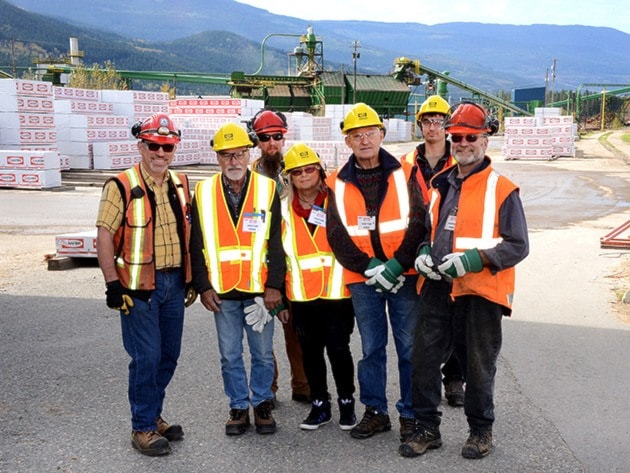Canfor’s Vavenby sawmill was turning out lumber at 85,000 board feet per hour during a public tour last week.
That was about how much the old Camp Two sawmill in Clearwater used to produce in a shift, according to Warren MacLennan, who used to load boxcars with lumber for Clearwater Timber Products 30 or 40 years ago.
Canfor-Vavenby more typically produces about 600,000 board feet of lumber per 10-hour shift, according to John Gerber, the sawmill’s human resources manager.
At two shifts per day, Monday to Thursday, that works out to 1.2 million per day or 4.8 million board feet per week.
In addition to the production shifts, there are three-12 hour shifts on Fridays, Saturdays and Sundays for maintenance and cleanup.
The sawmill has 143 hourly employees plus 20 staff and supervisors. There are also nine working in the forestry department.
The mill produces mostly spruce, pine and balsam lumber, with separate runs devoted to Douglas fir.
It produces its own fuel for its kilns by burning hog fuel, chips and shavings. Thermal oil is used to carry the heat from the furnace to the kilns.
Otherwise, most of the mill’s chips are sold to the Domtar pulpmill in Kamloops.
Despite the sawmill’s economic importance to the upper North Thompson Valley, only seven members of the public took part in the tour of the facility on Sept. 22 held as part of National Forest Week.
Logs coming into the sawmill are first put onto a log deck and are then debarked, said Gerber.
From there they go through one of three primary breakdown lines.
The 20-inch canter handles the majority of logs. The V6 line takes logs up to six inch diameter, while the head rig handles those up to 35 inches.
Having access to big wood allows the sawmill to produce larger dimension lumber such as 2x10s and 2x12s, Gerber said.
The cants or squared logs from the primary breakdown lines go through one of three gang-saws where they are cut all in one pass.
Seeing a 24 inch log reduced to multiple 2x4s in a few seconds is quite impressive, Gerber said.
The edger squares the edges on the lumber and sends back wood that needs to be cut again.
The trimmer used photo eyes and lasers to look at the wood before cutting it to length to get the best value. Present market prices are included in the calculation by the computer.
From the trimmer the lumber goes to an 80-bin sorter, where the wood is put into large vertical bins by length and dimension.
A stacker takes the rough lumber and puts it into lifts with spacers in between.
These are sent to the kiln to be dried.
Most is then sent to the planer, although some is sold unplaned.
The planer smooths all four sides and the wood is graded.
The grading is done electronically, although there is one ticketed grader on per shift for quality control.
After grading the wood is wrapped and then shipped, with most going by truck and the remainder by rail.
